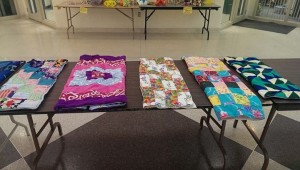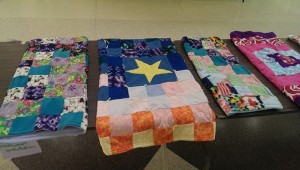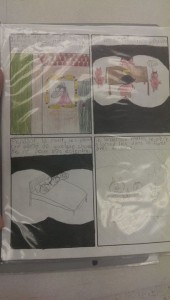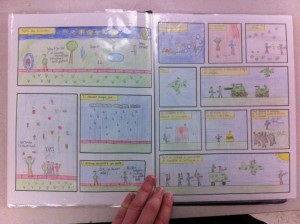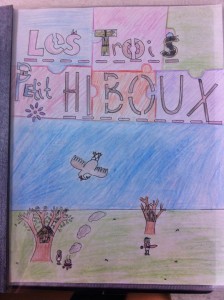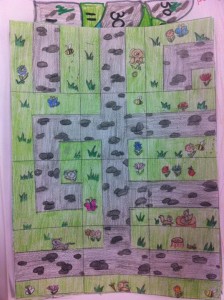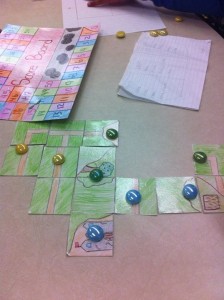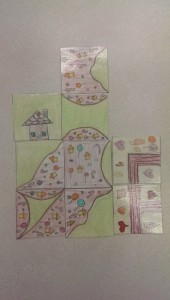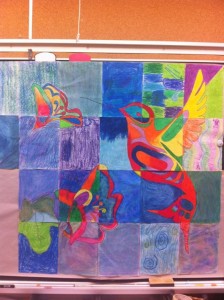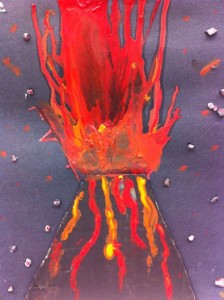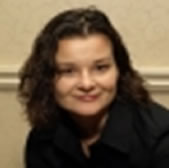I love Visual Art. It was always one of my favourite subjects in school and I was fortunate to have several teachers who engaged me in unique and exciting art projects. Tragically, I can’t have my students do Visual Arts all day, every day – bummer! Over the last few years, I’ve tried to find ways to integrate a bit of Visual Arts into many other subjects in ways my students don’t expect. Here are a few of my favourite projects from the last four years:
1) Quilts
What the project was: Working in groups, my class and another class of Grade 4/5 Middle French Immersion students designed, cut, and assembled baby quilts. At our annual art show, we ran a raffle for parents ($1/ticket). The proceeds from the raffle (over $300!) were donated to a charity. All of the material we used was donated by parents – much of it fabric ends from household projects, but some also salvaged from old pyjamas and blankets that were no longer wanted or needed.
What it taught my students: This project was a joint Visual Art and Mathematics project. From the VA side, it taught the use of tools (including electric sewing machines), complementary colours, patterning, and adapting to/solving design challenges. From the Mathematics side, it taught area and perimeter, measurement, and patterning.
What was challenging: We had 50 students cutting fabric, assembling quilts, and using sewing machines at the same time. The project took months (working one day a week) and the help of a few parent volunteers. I ended up giving up a few of my lunch breaks towards the end so that my students could finish their quilts before our art show.
2) Graphic Novels
What the project was: Students in my Grade 4/5 class each chose a fairy tale to retell in the form of a graphic novel. Their story had to be different in some way from the original without changing the overall message. They started by brainstorming, then created storyboards, then moved from storyboards to the actual comic panels.
What it taught my students: This was a joint VA/Language Arts project. From the VA side, it taught students composition, shading, line, perspective, and creating a narrative work of art. From the LA side, the expectations are always a little different depending on the grade level and program I’m teaching.
What was challenging: This project takes a long time. There are a lot of steps involved in getting to the final product, and students need a bit of guidance not to get too caught up in their storyboards. Many of them also needed to be encouraged to scale back their story so that it wasn’t 20 pages long – because 20 pages of comic panels is a LOT of drawing and colouring!
3) Carcassonne Variations
What the project was: Students in my Grade 4/5 Middle French Immersion class worked in groups to create their own versions of the board game Carcassonne. They had to plan/draw/colour their tiles and design a scoreboard. If they added any extra tiles that weren’t in the original game, they had to explain them with written rules.
What it taught my students: This was a joint VA/Mathematics project. I’ve used it to teach a variety of concepts in both areas. It changes a bit each year! For VA, I’ve used it to teach line, shape, colour, and texture. For Mathematics, I’ve mainly used it to teach probability (as the game involves drawing tiles from a bag) and fractions.
What was challenging: The first year that I did this project, I let students choose their own groups. Whoops! I ended up with several imbalanced groups – some with lots of artistic talent but who struggled with the mathematics side, others with lots of mathematical aptitude but who struggled with the artistic side, and everything in between. The next time I did this, I put students into groups, trying to balance artistic ability and mathematical aptitude… but as with any group put together by a teacher, occasionally my students had difficulty working together to plan and design a project like this.
Without going into too much detail, here are a few other Visual Arts activities I’ve done over the past few years:
Oliver Jeffers-inspired Picture Books (Visual Arts/Language Arts): We love Oliver Jeffers. His stories are whimsical, funny, colourful, and poignant. One of my favourite things to do with my students is have them create their own stories in the style of Oliver Jeffers. They get very creative!
Collaborative Mural (Visual Arts/community building): Each student received a piece of the mural without knowing what the final design would be. Their page had only black linework on it, with some areas coded to be coloured with hot colours and others coded to be coloured with cold. When they finished, we assembled them according to the numbers I had put on the back of each page.
Melted Crayon Art (Visual Arts/Science)

